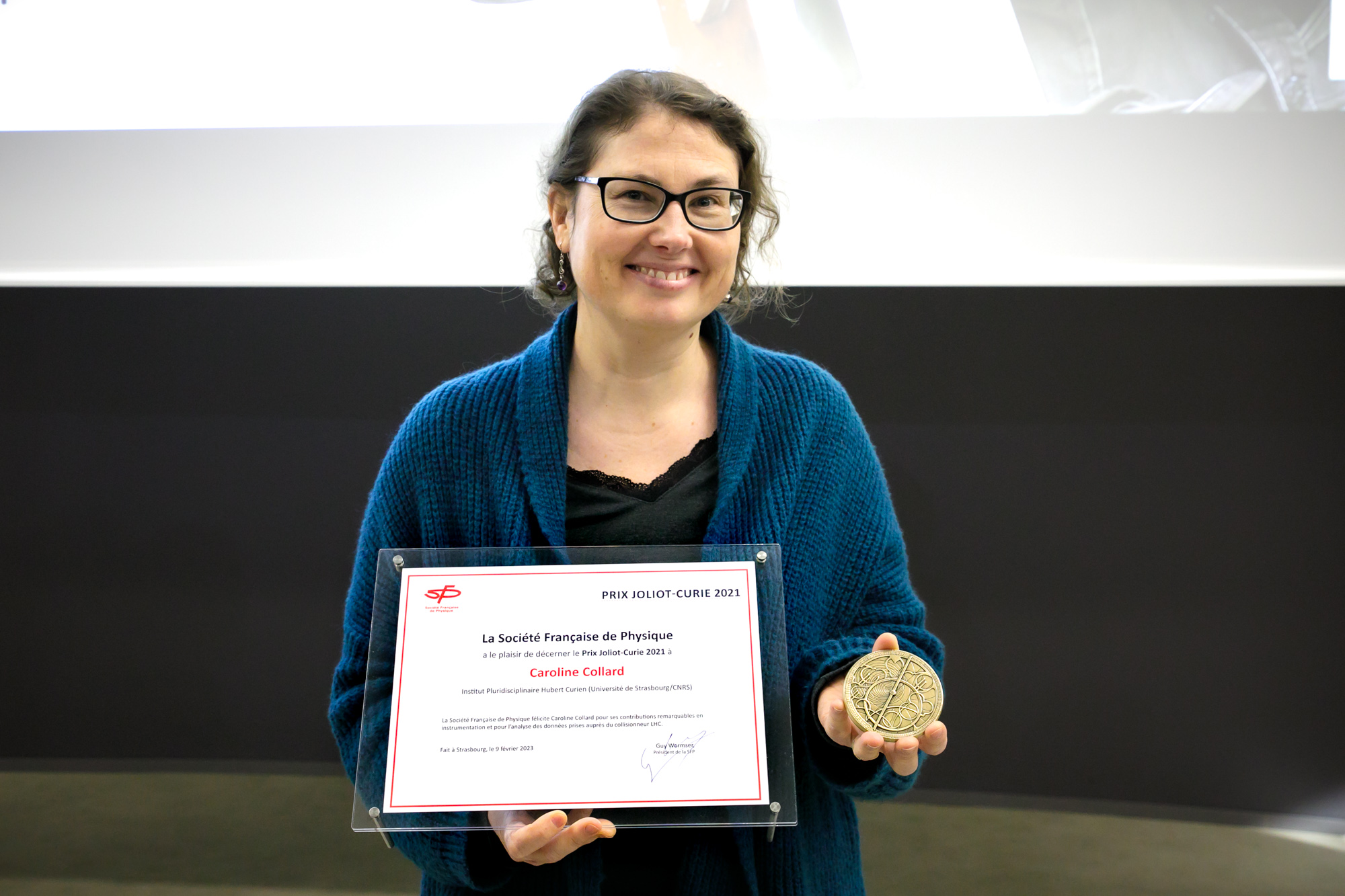Did you know that on the 9th of February 2023 one of our CMS scientists got awarded by the French Physical Society (SFP)?
Caroline Collard received the 2021 Joliot- Curie Prize! The award recognises nuclear and particle physicists, and has been doing so since 1956. As the ceremony of Caroline’s prize took place last month, we asked her a few questions about her successful career!

Caroline, tell us a few things about yourself and your work.
I am a Belgian physicist working at IPHC (Institut Pluridisciplinaire Hubert Curien), a French lab in Strasbourg, in France. I am passionate about my work and I have two kids, so I try to find the best work-family balance. I like dancing and reading books and comics. Some years ago I started learning to play the alto flute. I like to keep learning and challenging myself.
I started my career in Belgium. I did all my studies in Brussels and did my PhD there too, working on the H1 experiment (at the HERA collider in Hambourg). Then I moved to France for a postdoc, joining the CMS collaboration. This was long before the start of the LHC. I worked on the preparation of physics analyses, in the context of searching for extra dimensions. I also had some technical contribution, working on the test of Front-End boards for the electromagnetic calorimeter of CMS (ECAL), to determine whether these boards could then be installed in the CMS detector.
After that, I got a permanent position in Orsay to work on the ATLAS collaboration. I continued to work on an electromagnetic calorimeter, but this time on the Liquid Argon (LAr) calorimeter of ATLAS.
In summer 2010, I moved to Strasbourg, joining the CMS collaboration again. This time, the group that I am part of works on the tracker detector, which has completely changed my work topic. I started to be interested in b-tagging (how we can identify b-quarks in the CMS detector). I was a convener of the CMS b-tagging group between 2015 and 2017. On the analysis side, I contributed to searches for supersymmetry, searching in particular for the supersymmetric partner of the top quark. I am now searching with a more exotic approach.
What inspired you to become a particle physicist?
I became a particle physicist thanks to the people I met during my studies and also in a large part due to chance. Initially, I wanted to do my end-of-studies internship in the field of chaos physics but the professor who could have supervised my internship was leaving for a year in the USA. So I changed my mind and ended up with an internship in particle physics. I have never regretted it! I was, also, very lucky when I got a permanent position in France, passing the CNRS competitive entrance examinations for researchers.
I really appreciate the opportunity provided by my job to meet a lot of new people. The collaborative aspect of the work is essential for me.
Can you describe the main project you are currently working on?
My current main activity is the search for signs of new physics. I am searching for hypothetical new, massive, and electrically charged particles, with a sufficiently long lifespan to be ‘stable’ by experimental standards. Because of their large mass, these particles are expected to leave much larger energy deposits along their path through the tracker. It is very interesting to search for them with an analysis using very low level information from the tracker. The ATLAS collaboration has observed an excess with a similar analysis. Therefore I am particularly curious about what the data recorded by the CMS detector will tell us…
I have also a parallel activity in the context of CMS tracker upgrade for which the IPHC group is deeply involved. At Strasbourg, we have a dedicated beam line at the Cyrcé facility, where we can perform beam tests and test the modules of the CMS future tracker foreseen for the High Luminosity phase of the LHC. I was working on building a small experiment setup called a telescope in particle physics (but which has nothing to do with a telescope to observe the sky), that measures the position of the proton beam from Cyrcé and predicts the beam position in the module under test by extrapolation. This information is important to know for performance measurements.

What could the discovery of these particles possibly mean for us?
It would be like landing on the shores of a completely new continent. So far we have only explored the land of the Standard Model of Particle Physics, but we know there must be more elsewhere. Theorists have plenty of ideas of the direction we could sail, but for the moment the new continent eludes us... Sometimes we find intriguing experimental results, but nothing that has led to a discovery yet. So, we continue searching… Finding a new particle would change our understanding of the infinitely small.
If you had a teenager in front of you wanting to pursue a career in particle physics, what would you tell them?
Follow your dreams, and give yourself the means to reach your goal. Doing a job that you love is vital!
Disclaimer: The views expressed in CMS blogs are personal views of the author and do not necessarily represent official views of the CMS collaboration.
